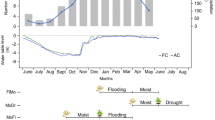Summary
Seedling establishment of Polygonum cuspidatum Sieb. et Zucc. colonizing in a volcanic gravel area at 1,400 m and 2,500 m altitude on Mt. Fuji was compared. At the upper altitudinal limit (2,500 m) the average dry weight of seedlings at the end of the first growing season after germination was 24 per cent of that at 1,400 m. The proportion of seedlings, which survived the winter, was significantly (P<0.005) higher at 1,400 m than at 2,500 m. Seedlings in the range of 0–10 mg DW could not survive winter at any altitude. The survival rate increased with increasing seedling dry weight up to 100 per cent in seedlings with sizes more than 40 mg DW at 1,400 m. Seedlings from 2,500 m with sizes below 2 mg DW did not form perennation buds and were found to die before winter. Smaller seedlings in the range of 2–20 mg DW, even if they had buds, did not survive in the-15°C freezing resistance experiment. Larger seedlings (40–100 mg DW), which were grown in pots at 1,400 m and transferred to 2,500 m, survived winter those like as at 1,400 m. The difference in mean seedling dry weight between at 1,400 m and at 2,500 m was attributable to the difference in the length of the growing season and not to a different relative growth rate. It appears that there is a critical amount of annual dry-matter production necessary for full freezing resistance and winter survival capacity and therefore for successful seedling establishment.
Similar content being viewed by others
References
Cook RE (1980) Germination and size-dependent mortality in Viola blanda. Oecologia (Berlin) 47:115–117
Grime JP (1966) Shade avoidance and tolerance in flowering plants. In: Bainbridge R, Evance GC, Rackham O (eds) Light as an ecological factor. Blackwell Scientific Publications, Oxford, pp 281–301
Larcher W, Bauer H (1981) Ecological significance of resistance to low temperature. In: Encyclopedia of Plant Physiology, 12A. Springer, Berlin, pp 403–437
Levitt J (1980) Factors related to freezing resistance. In: Responses of plants to environmental stresses, 2ed. Academic Press, New York London, pp 163–227
Maruta E (1976) Seedling establishment of Polygonum cuspidatum on Mt. Fuji. Jap J Ecol 26:101–105
Maruta E, Saeki T (1976) Transpiration and leaf temperature of Polygonum cuspidatum on Mt. Fuji. Jap J Ecol 26:25–35
Ohsawa M, Totsuka T (1973) Photosynthesis of several plants species on Mt. Fuji. (in Japanese) JIPP/PP photosynthesis Level III 49–52
Rabinowitz D (1978) Mortality and initial propagule size in mangrove seedlings in Panama. J Ecol 66:45–51
Werner PA (1975) Predictions of fate from rosette size in Teasel (Dipsacus fullonum L.). Oecologia (Berlin) 20:197–201
Author information
Authors and Affiliations
Rights and permissions
About this article
Cite this article
Maruta, E. Growth and survival of current-year seedlings of Polygonum cuspidatum at the upper distribution limit on Mt. Fuji. Oecologia 60, 316–320 (1983). https://doi.org/10.1007/BF00376845
Received:
Issue Date:
DOI: https://doi.org/10.1007/BF00376845




